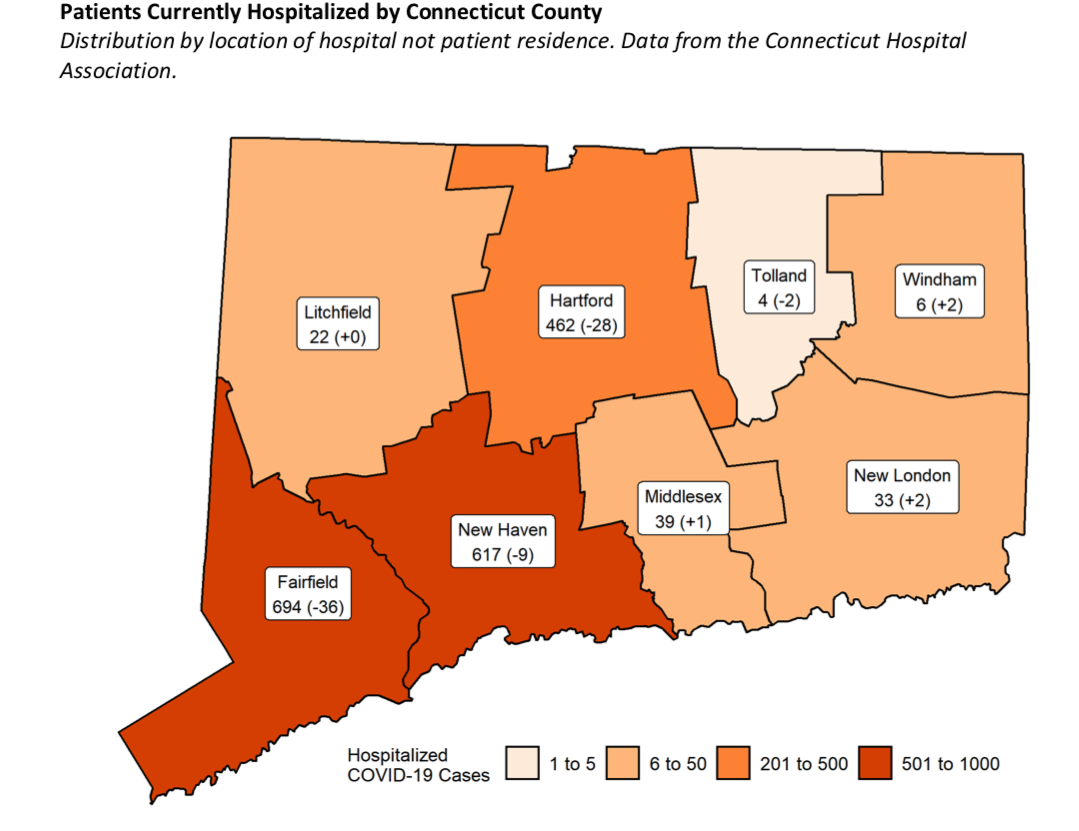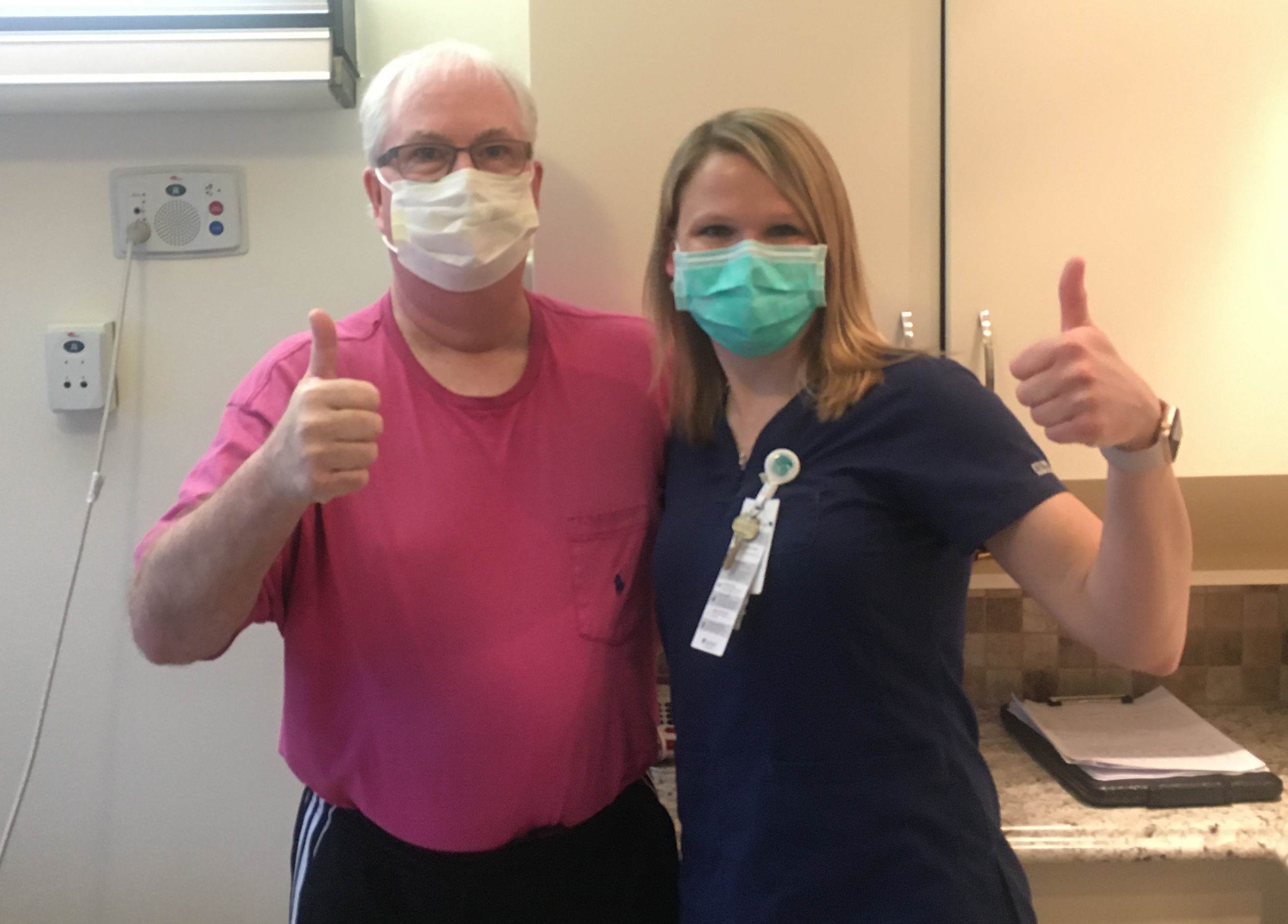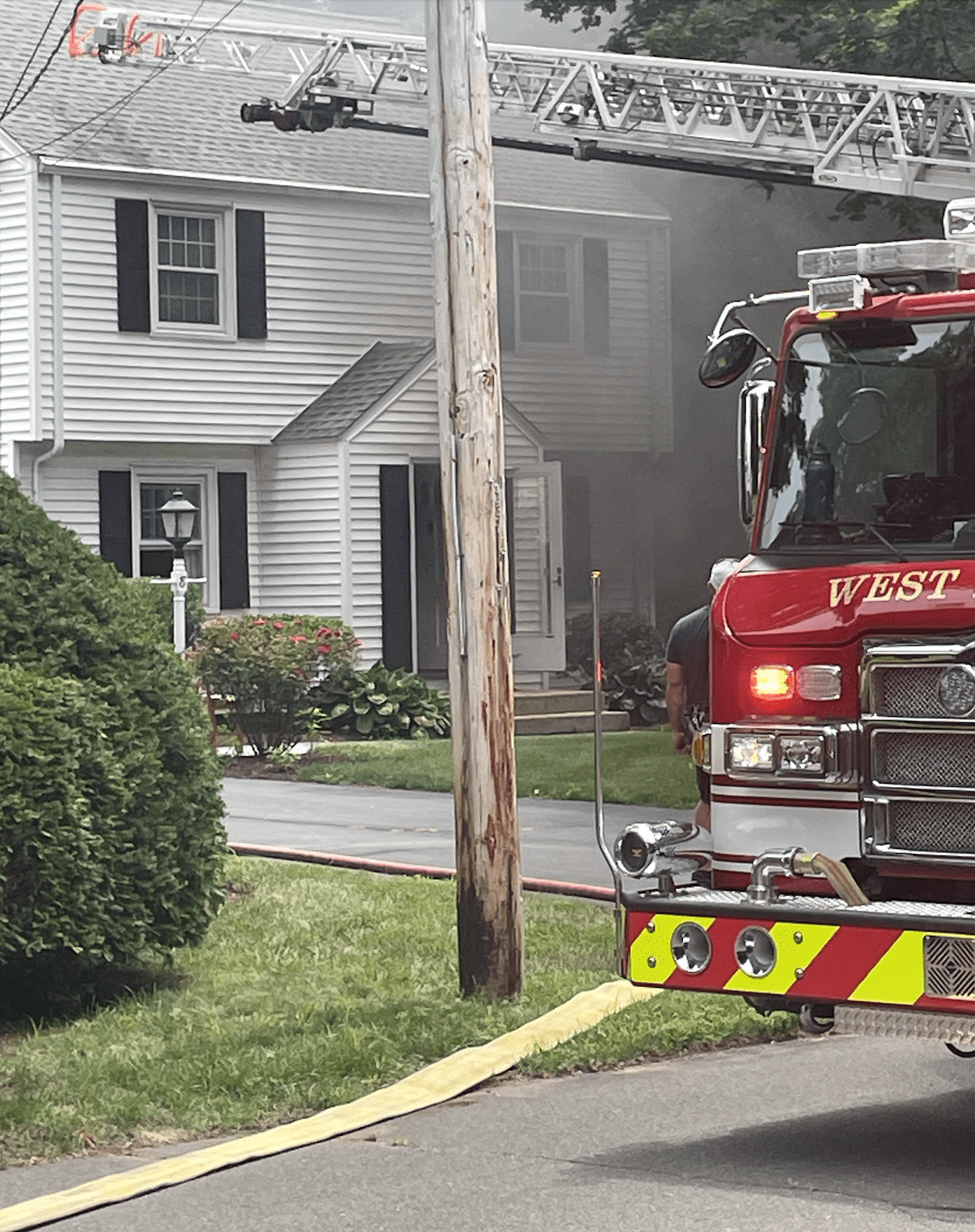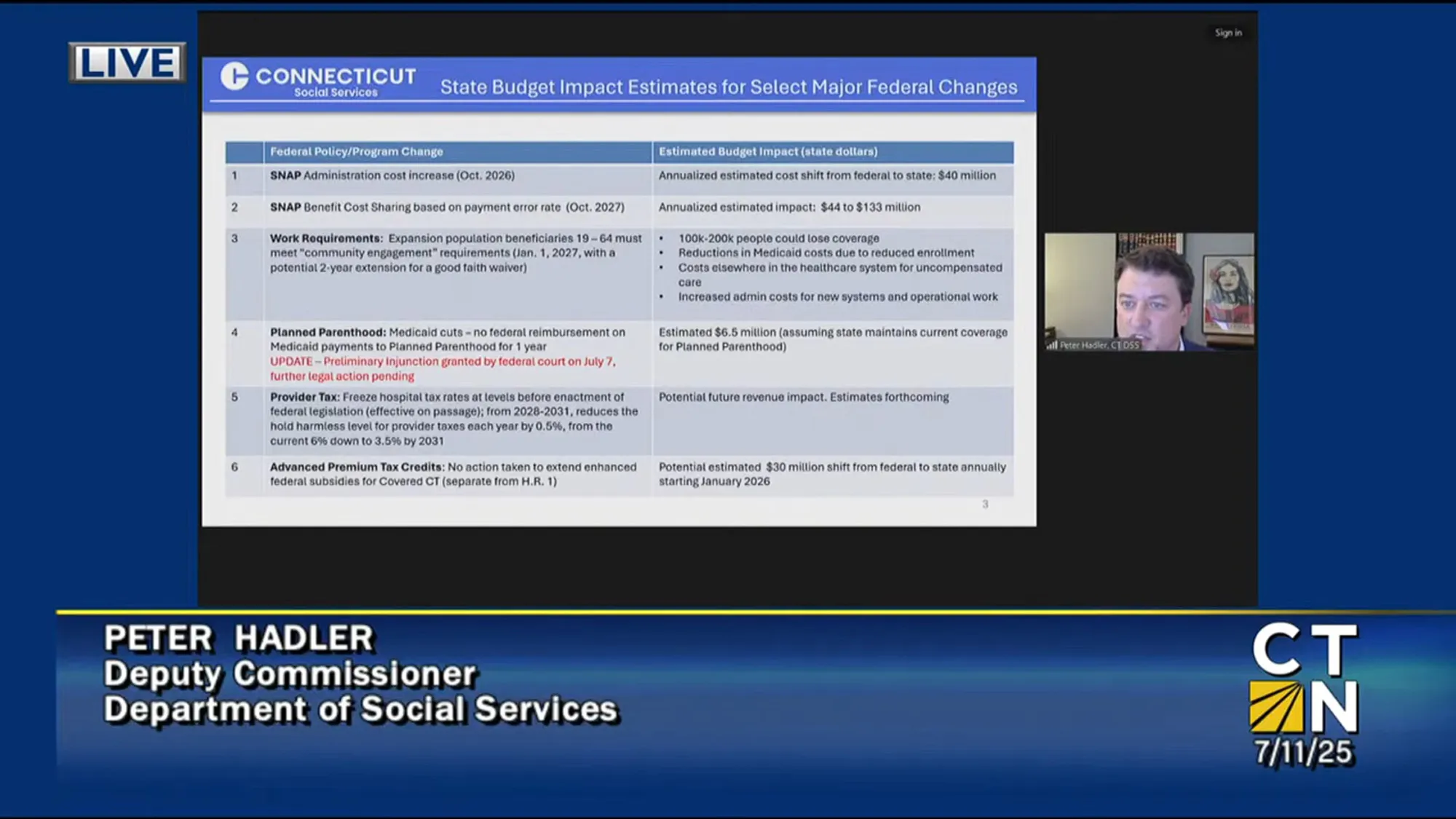COVID-19 Hospitalizations See Largest One-Day Drop Since State began Tracking

Audio By Carbonatix

Hospital workers man the registration station at the Prescribed Alternative Testing Hub (PATH) in the portico of the Wheeler Building at Stamford Hospital where people can get tested for COVID-19. Appointments for tests are required and spaced five minutes apart. Those seeking testing drive up to the PATH and get out of their car for the test which takes just a couple of minutes. On Friday, the hospital tested 90 people. Photo credit: Cloe Poisson, CTMirror.org
There are currently 1,877 people hospitalized with the virus, a drop of 70 from yesterday. Another 125 people have died, including three more in West Hartford.
By Gregory B. Hladky, CTMirror.org
West Hartford-specific information provided by Ronni Newton, We-Ha.com
Coronavirus hospitalizations in Connecticut saw their biggest one-day decrease Friday since the state began tracking – a fact Gov. Ned Lamont seized as a hopeful sign despite the continued daily increases in deaths resulting from COVID-19.
State officials reported that patients now hospitalized with the virus total 1,877, a drop of 70 from the previous day. An additional 125 people died from COVID-19, bringing the Connecticut death toll to 1,764. The death toll includes three state employees who worked in Connecticut’s Department of Developmental Services who died after contracting the coronavirus, officials reported Friday.
On Friday, according to data released by the state, West Hartford had a total of 238 residents with a confirmed positive case of COVID-19 – an increase of 16 from the previous day – and 33 fatalities.

At his Friday briefing, Lamont called the ongoing reduction in hospitalizations “so positive.” He said another week of declines in the number of people needing hospital care for the coronavirus could bring the state closer to reopening some portions of the economy.
Stamford Hospital, which has been near the epicenter of Connecticut’s COVID-19 crisis for weeks, is now seeing “a bit of a turn-down” in hospitalization for the virus, said Kathleen Silard, president and CEO of that hospital, who joined Lamont for his Friday briefing.
Friday was the first day in weeks that non-COVID-19 patients outnumbered coronavirus patients at the hospital, said Silard.

Silard also urged residents who may need hospital care for non-COVID-19 reasons not to put off those surgeries or procedures. While people may be afraid to seek hospital care because of the coronavirus, she said, they should be assured that Connecticut hospitals still have the ability to provide necessary care.
Despite the improving hospitalization numbers, the governor again warned of the risks of a “second surge” of the virus if schools and businesses are allowed to reopen too soon. Lamont has set May 20 as a key date, with all schools and most non-essential businesses closed at least until then.
“I’m afraid this is going to go on for some time,” Lamont said.
Lamont said that “it’s possible” some small businesses like restaurants and bars might be allowed to reopen before June under limited circumstances if widespread testing shows a continuing decline in the risk of a second round of coronavirus infections.
But he also said “it makes all the sense in the world to me” to keep all the auxiliary hospital facilities that have been set up open and ready in case a second wave of the virus hits.
The state’s push to ramp up testing for COVID-19 resulted in an additional 2,541 people being checked for the disease in the previous 24 hours, according to Friday’s report. A total of 74,038 people have now been tested for the coronavirus in Connecticut and Lamont said his administration will be rolling out plans for additional widespread testing next week.
Lamont also said officials are working to address problems in the food supply chain that are taxing the ability of the state to respond to increased demand at Connecticut’s over-burdened food banks.
UConn faculty told to begin planning for online fall semester
UConn President Thomas Katsouleas sent a letter to faculty, students, and staff Friday announcing the decision to move the second summer session, which begins July 13, to online or remote learning education. The university had already decided to cancel face-to-face instruction for the first summer session.
While saying that no decision has yet been made, Katsouleas asked faculty to begin planning for an online fall semester as well.
“The decision regarding face-to-face classes for fall 2020 will be made with the approval of the Board of Trustees and communicated before June 30, 2020,” Katsouleas wrote. “Factors contributing to that decision will include the progress on slowing COVID-19, guidance from public health experts, decisions and guidance from federal and state government, and the availability of testing, among others. Though no decision has been made, faculty should plan as though courses will be delivered online in the fall.”
Big corporate donation of critical medical equipment
Raytheon Company and United Technologies are donating $3 million to buy and transport critical personal protective equipment [PPE] for medical personnel and first responders, the administration announced Friday.
The donation includes 455,000 KN95 medical masks, 325,000 surgical masks, 120,000 protective coveralls and 4,500 intensive care unit coveralls, according to state officials.
All the equipment is being bought in China and the first shipment is scheduled to arrive in the state Saturday.
“Getting PPE to front-line workers who are battling this pandemic is a top priority,” Lamont said. He praised Raytheon Technologies for using its resources ” to boost Connecticut’s supplies and get this equipment to those who need it the most.”
A coronavirus success story
The remarkable recovery of a Hartford Hospital COVID-19 patient, a man so close to death that he had to be paralyzed just to allow him to breathe, has become a beacon of hope for doctors and nurses fighting this deadly disease.
“You have changed the game for all of us,” Dr. Megan Panico told 54-year-old Jay Bialkowski during a Friday conference call about his recovery. Panico, who was fighting back tears as she spoke, said his recovery has proved to all his doctors, nurses and therapists that even the worst coronavirus cases can be saved.
At a point in time when experts say the pandemic is near its peak in this state, the story of Bialkowski’s dramatic recovery was offered by Hartford Healthcare officials as evidence of the kind of progress being made in the campaign to save victims of this deadly virus.

Retired state trooper Jay Bialkowski of Glastonbury with Katie Zimmerli, a therapist at Gaylord Hospital. Courtesy of CTMirror.org
Bialkowski, a retired state police officer working as a security guard at Hartford Hospital, was at home when he started coming down with symptoms of the virus. Having trouble breathing, coughing and with a high fever, he was brought into the hospital’s emergency room March 25.
Dr. Sam Pope, director of Hartford Hospital’s intensive care unit, said Bialkowski was “as ill as a person gets with this disease.” A breathing tube was put in to give him oxygen, but by March 30 Bialkowski was in such dire shape he was given medicine to paralyze his muscles to keep them from using too much oxygen.
Panico, a pulmonary critical care physician at the hospital, said Bialkowski was one of the sickest COVID-19 patients she’s ever treated. “I was afraid I wasn’t going to be able to give him his life back,” she said.
Bialkowski, a long-time Glastonbury resident, said he doesn’t recall much about the weeks when he was near death. He said one of his first memories during his ordeal was when he had recovered enough to be moved from intensive care and transferred to Gaylord Hospital for therapy. Bialkowski said it was a rainy day as he was wheeled out on a stretcher to an ambulance. “I remember how amazing the wet rain felt on my face,” he said.
Hartford Hospital doctors said Bialkowski’s amazing recovery was due largely to his determination and desire to beat the disease.
Now able to stand and move about with the help of a walker, Bialkowski said his intense motivation to get well was simply his desire to go home to his wife and children. Doctors said he is due to be sent home Saturday.
“I am so, so eternally grateful,” Bialkowski said of everyone who helped him come back from the point of death.
Mobile testing program to open in Hartford
Another sign of Connecticut’s efforts to increase testing for coronavirus is a new plan for a mobile test site in Hartford that is scheduled to be in operation early next week.
The mobile test program, which officials say they expect to expand across the Hartford region, is being set up by Hartford Healthcare and Hartford city government.
Lamont has repeatedly said Connecticut dramatically needs to expand its COVID-19 testing in order to determine when it will be safe to reopen schools and many businesses. Currently, the governor has ordered schools, bars, restaurants and most small businesses to remain closed until at least May 20.
Hartford officials also announced this week that Hartford residents will be able to get free transportation to coronavirus testing stations starting Friday.
About 40% of the city’s residents don’t have access to a car, and officials said that has been a barrier to getting more people in Hartford tested. As of Friday, a city resident with a testing appointment can call 860-757-9311 to arrange for transportation to and from their test site.
Housing for newly released inmates
The Office of Policy Management announced Thursday that it has awarded a grant of $148,500 to help people released from prison and jail secure housing. The funds can be used for housing-related costs like moving expenses, security deposits and rental assistance.
The money is the same – although it has been adjusted slightly – as the funds Richard Cho, CEO of the Connecticut Coalition to End Homelessness, reported as being available in late March. The money is for placing inmates at the end of their sentences in a hotel or for providing them with rapid rehousing services.
Each month, the Department of Correction releases around 50 people from jails or prisons to homelessness because they don’t have a place to live.
“We’re quickly running out of money in that we’ve already had, I think, 20 or 30 referrals from DOC, so we’re projecting they’re [going to] need several months of rental assistance money,” Cho said., He said the money that’s been made available is “only a months’ worth of assistance.”
Cho said most of the funds have been used to put people up in hotels, though some individuals have found permanent housing.
Cho said the pandemic could pose further troublesome financial problems to the former inmates as unemployment remains high, making successful reentry even more difficult. Those who are unable to find a job become less likely to be able to pay rent. The extra, compounded aid could use up the money the state has made available to help prevent homelessness.
“The longer we have to keep people on rental assistance, the fewer people we can help,” said Cho. Cho said other cities and philanthropic entities are in talks to provided added funds. “Now it’s just a matter of, ‘Let’s put more money into it so we can expand capacity,’” he said.
“Our Department of Correction views housing as one of the most important factors for successful reentry, and safe and stable housing has become even more critical as we face the additional challenges around the COVID-19 pandemic,” said Rollin Cook, Department of Correction commissioner, said in a statement. “This progressive new program will enable DOC to prevent more people from leaving DOC only to wind up homeless, not only during these difficult times, but well into the future.”
Children at juvenile detention centers recover from COVID-19
All seven of the children at the Hartford Juvenile Detention Center who had contracted the virus have recovered and been released from isolation, a spokesperson for the Judicial Branch said Friday.
No children held at either of the state’s two juvenile detention centers are currently showing symptoms of COVID-19.
Eight staff at the Hartford facility have recovered and returned to work. Five staff at Bridgeport are recovering. No children have tested positive at the Bridgeport Juvenile Detention Center.
As of Friday, there were 27 boys at the Bridgeport facility, and 19 at the one in Hartford.
CT Mirror Reporter Kelan Lyons contributed to this story.
Reprinted with permission of The Connecticut Mirror.
Like what you see here? Click here to subscribe to We-Ha’s newsletter so you’ll always be in the know about what’s happening in West Hartford! Click the blue button below to become a supporter of We-Ha.com and our efforts to continue producing quality journalism.



